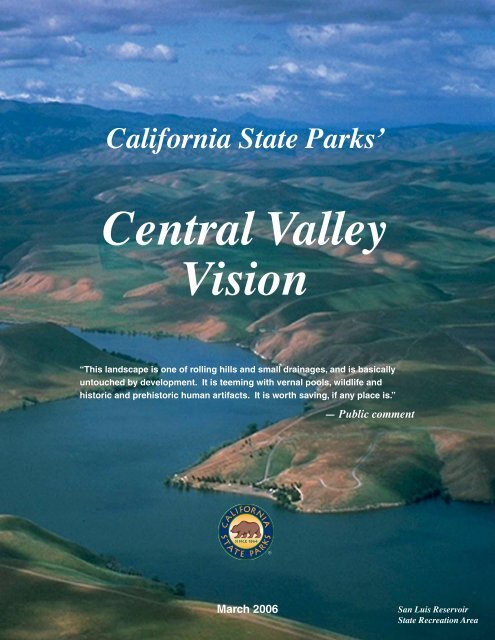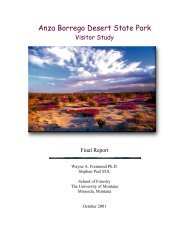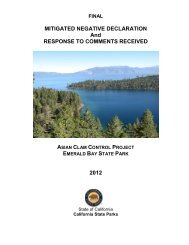Central Valley Vision - California State Parks
Central Valley Vision - California State Parks
Central Valley Vision - California State Parks
Create successful ePaper yourself
Turn your PDF publications into a flip-book with our unique Google optimized e-Paper software.
<strong>California</strong> <strong>State</strong> <strong>Parks</strong>’<br />
<strong>Central</strong> <strong>Valley</strong><br />
<strong>Vision</strong><br />
“This landscape is one of rolling hills and small drainages, and is basically<br />
untouched by development. It is teeming with vernal pools, wildlife and<br />
historic and prehistoric human artifacts. It is worth saving, if any place is.”<br />
— Public comment<br />
March 2006<br />
San Luis Reservoir<br />
<strong>State</strong> Recreation Area
Director’s Message<br />
The population of <strong>California</strong>’s Great <strong>Central</strong> <strong>Valley</strong> is growing and<br />
changing like never before. As individuals, <strong>Central</strong> <strong>Valley</strong> residents are<br />
learning new technologies, attending new institutions of higher education,<br />
and diversifying their employment and economic opportunities. As a<br />
population, the numbers of <strong>Central</strong> <strong>Valley</strong> dwellers are expected to more<br />
than double by 2040, and include more ethnic diversity than many places<br />
in the nation.<br />
Ruth Coleman, Director<br />
<strong>California</strong> <strong>State</strong> <strong>Parks</strong> recognizes the importance of providing excellent<br />
service to the residents of the heartland of <strong>California</strong>, and has worked to identify strategies<br />
for meeting the dynamic needs of the <strong>Central</strong> <strong>Valley</strong>. In 2005 we took those strategies to the<br />
people and listened to what they had to say. Overall, public comments supported our strategies<br />
to increase and improve park and recreation services to residents and visitors. We heard<br />
enthusiastic testimony on the proud heritage, natural splendors, abundant recreational resources,<br />
and dynamic future of the <strong>Valley</strong>.<br />
<strong>California</strong> <strong>State</strong> <strong>Parks</strong> looks forward to continuing to work with our many partners to implement<br />
improvements to the <strong>State</strong> Park System in the <strong>Central</strong> <strong>Valley</strong>. Please continue to consider how<br />
we can all contribute to the health, inspiration and education of all <strong>California</strong>ns by preserving<br />
what’s best about the <strong>Central</strong> <strong>Valley</strong> for current and future generations.<br />
Leland Stanford Mansion <strong>State</strong> Historic Park<br />
Prairie City <strong>State</strong> Vehicular Recreation Area<br />
“As Mayor of the largest city in the <strong>Central</strong> <strong>Valley</strong>, I am very pleased that <strong>California</strong> <strong>State</strong> <strong>Parks</strong> is taking<br />
a serious look at the future of the <strong>Valley</strong> resources and the long-term needs of <strong>Central</strong> <strong>Valley</strong> residents.”<br />
— Heather Fargo, Sacramento<br />
2
Project Overview<br />
Establishing the <strong>Vision</strong>—In 2003 <strong>California</strong> <strong>State</strong> <strong>Parks</strong> initiated an<br />
ambitious research effort to analyze gaps in park and recreational<br />
<br />
<strong>Valley</strong>. By collecting this information, <strong>California</strong> <strong>State</strong> <strong>Parks</strong> intended to<br />
better guide park acquisition and development activities over a longterm<br />
(20-year) planning horizon.<br />
An oversight committee, consisting of various <strong>Central</strong> <strong>Valley</strong> leaders<br />
and advocates, was established to help guide the effort. Through<br />
their suggestions, it was determined that <strong>California</strong> <strong>State</strong> <strong>Parks</strong> can<br />
better serve the needs of <strong>Central</strong> <strong>Valley</strong> residents and visitors through Caswell Memorial <strong>State</strong> Park<br />
a conscientious program of protecting lands and developing facilities<br />
at new and existing units. The following broad recommendations were proposed to guide the next<br />
phase of the project:<br />
Expand recreational facilities to accommodate larger families and groups in existing parks.<br />
Expand landholdings at existing parks and acquire new parklands along major river corridors.<br />
Acquire lands that preserve and protect vanishing natural resources.<br />
Better preserve and interpret the rich history associated with the <strong>Valley</strong>’s past.<br />
In 2004 the brochure, <strong>California</strong> <strong>State</strong> <strong>Parks</strong> & the Great <strong>Central</strong> <strong>Valley</strong>, was released. This<br />
publication outlined the initial project and its recommendations. <strong>California</strong> <strong>State</strong> <strong>Parks</strong> & the Great<br />
<strong>Central</strong> <strong>Valley</strong> can be accessed on the <strong>State</strong> <strong>Parks</strong> Web site at www.parks.ca.gov/centralvalley.<br />
Bringing the <strong>Vision</strong> to the Public—In 2005 <strong>California</strong> <strong>State</strong> <strong>Parks</strong> sought feedback from the general<br />
public through an extensive outreach effort. This effort included 11 public meetings throughout the<br />
ty<br />
interest groups. The public was also invited to submit their comments electronically. In response to<br />
<br />
<br />
Making it Happen: Implementation of <strong>State</strong> <strong>Parks</strong>’ Recommendations—<strong>State</strong> <strong>Parks</strong> has<br />
<br />
be found on pages six and seven. <strong>State</strong> <strong>Parks</strong> will continue to develop long-range goals<br />
over the next 20 years.<br />
Sutter Buttes<br />
3
5<br />
Defining the <strong>Central</strong> <strong>Valley</strong><br />
1<br />
Redding<br />
5<br />
2<br />
3<br />
Chico<br />
4 5<br />
9<br />
San Francsico<br />
8<br />
7<br />
99<br />
10<br />
Sacramento13<br />
80<br />
15<br />
16<br />
17<br />
18<br />
5<br />
6<br />
99<br />
12<br />
11<br />
14<br />
Stockton<br />
19<br />
21 20 Modesto<br />
22<br />
23<br />
5<br />
24<br />
25<br />
Merced<br />
26<br />
27<br />
80<br />
50<br />
The <strong>Central</strong> <strong>Valley</strong>’s<br />
<strong>State</strong> Park Units<br />
5<br />
99<br />
28<br />
Fresno<br />
Visalia<br />
29<br />
99<br />
30 Bakersfield<br />
For this effort, the <strong>Central</strong> <strong>Valley</strong> is geographically<br />
<br />
approximately from Redding in the north to the<br />
Tehachapi Mountains in the south, and from the<br />
<br />
elevation along the Coast Range and along the<br />
Sierra Nevada. Collectively these 18 counties<br />
are home to 17 percent of the state’s population,<br />
and account for 15 million acres (15 percent) of<br />
<strong>California</strong>’s total acreage.<br />
The <strong>Valley</strong>’s natural resources are diverse and<br />
unique; some plant assemblages and animal<br />
species are found nowhere else in the world.<br />
Rivers and streams provide a cool respite for both<br />
people and animals during hot, dry summers,<br />
and host migratory birds in winter. In spring<br />
<br />
viewers.<br />
The <strong>Valley</strong>’s historic and cultural heritage is also<br />
rich and varied, ranging from the discovery of<br />
gold in the foothills to the growth of agriculture in<br />
the <strong>Valley</strong>; from the waves of immigrants to the<br />
<br />
the mysteries of prehistoric rock art sites to the<br />
legacy of the railroads.<br />
These resources provide a multitude of park<br />
and recreation opportunities in the <strong>Valley</strong><br />
and foothills nearby. Federal, state,<br />
and local parks, historic sites,<br />
museums, and open space<br />
areas provide opportunities<br />
for short day excursions and<br />
vacation destinations.<br />
4<br />
1. <br />
<br />
3. Woodson Bridge SRA<br />
4. Bidwell-Sacramento River SP<br />
<br />
6. Lake Oroville SRA<br />
7. Clay Pit SVRA<br />
8. Sutter Buttes<br />
9. Colusa-Sacramento River SRA<br />
<br />
11. Folsom Lake SRA<br />
<br />
13. <strong>State</strong> Capitol Museum<br />
<br />
5<br />
Museum<br />
<br />
<br />
Museum<br />
<br />
Los Angeles<br />
14. Prairie City SVRA<br />
15. Stone Lake<br />
16. Delta Meadows<br />
5<br />
17. Brannan Island SRA<br />
18. Franks Tract SRA<br />
5<br />
19. Bethany Reservoir SRA<br />
20. Caswell Memorial SP<br />
21. Carnegie SVRA<br />
22. Turlock Lake SRA<br />
23. McConnell SRA<br />
<br />
25. Great <strong>Valley</strong> Grasslands SP<br />
26. Pacheco SP<br />
27. San Luis Reservoir SRA<br />
28. Millerton Lake SRA<br />
<br />
30. Tule Elk SR
What We Heard<br />
Common concerns and recommendations<br />
emerged from the comments gathered during the<br />
public outreach effort.<br />
<br />
<br />
boat ramps, water trails, and entrance/egress<br />
areas for water recreation.<br />
Acquire land featuring oak woodlands, river<br />
Folsom Lake <strong>State</strong> Recreation Area<br />
access, and other high-demand sites threatened<br />
by development, while land is available and before prices skyrocket.<br />
Increase the number of camping facilities, including larger sites that can accommodate multifamily<br />
groups, and more amenity-rich alternative facilities such as cabins and tent cabins.<br />
Increase trail recreation opportunities, including trails along river corridors, trails that traverse<br />
the <strong>Central</strong> <strong>Valley</strong> and connect the ocean and Sierra Nevada, equestrian trails, and off-highway<br />
recreation areas.<br />
<br />
<br />
communities, the impact of water development and use in the <strong>Central</strong> <strong>Valley</strong>, and the use of<br />
waterways as transportation corridors. The public also requested more visitor/welcome centers<br />
and interpretive signage and displays.<br />
Increase funding for operation and maintenance of local parks (regional, county and city). Many<br />
hoped to transfer local park lands to the <strong>State</strong> Park System due to lack of operating funds.<br />
“Now is the time to provide some recreation facilities—<br />
before it all becomes rooftops!”<br />
— Public comment<br />
2005<br />
Public Meetings<br />
April 27 - Woodland<br />
May 31 - Fresno<br />
June 1 - Sacramento<br />
June 8 - Chico<br />
Sept. 13 - Isleton<br />
<br />
Sept. 15 - Madera<br />
Sept. 19 - Red Bluff<br />
Sept. 20 - Modesto<br />
Sept. 21 - Atwater<br />
Sept. 27 - Stockton<br />
Colonel Allensworth <strong>State</strong> Historic Park<br />
5
Progress and<br />
Continued Activities<br />
Since the initiation of the <strong>Central</strong> <strong>Valley</strong> <strong>Vision</strong>, <strong>California</strong> <strong>State</strong> <strong>Parks</strong><br />
<br />
following:<br />
Expand Recreational Facilities. In response to changing<br />
demographics and demand, <strong>State</strong> <strong>Parks</strong> is identifying opportunities to<br />
increase high-quality, in-demand recreational facilities.<br />
<strong>State</strong> <strong>Parks</strong> is partnering with the Department of Boating and<br />
Waterways to develop boat launches and day-use facilities at<br />
numerous <strong>Central</strong> <strong>Valley</strong> state parks.<br />
<strong>State</strong> <strong>Parks</strong> has researched and developed guidelines for implementing alternative camping<br />
facilities (such as cabins and tent cabins) in state parks.<br />
Expand Land Holdings. <strong>State</strong> <strong>Parks</strong> seeks to identify and prioritize properties that feature<br />
threatened natural resources, cultural resources, and multiple active or passive recreational<br />
opportunities. <strong>State</strong> <strong>Parks</strong> is also considering acquisition of adjacent properties that buffer<br />
protected natural resource areas from encroaching incompatible uses, connecting existing<br />
<br />
opportunities.<br />
<br />
an off-highway vehicle recreation area.<br />
<strong>State</strong> <strong>Parks</strong> acquired nearly 1,800 acres in the Peace <strong>Valley</strong> of the Sutter Buttes, protecting<br />
unique natural and cultural resources.<br />
Preserve and Interpret Unique Cultural Resources and Stories. <strong>State</strong> <strong>Parks</strong> is investigating<br />
opportunities to increase preservation and interpretation of the many stories of <strong>California</strong>.<br />
<strong>State</strong> <strong>Parks</strong> is working with Caltrans and the Great <strong>Valley</strong> Center to develop interpretive<br />
programs to tell the many stories of the Highway 99 corridor.<br />
<strong>State</strong> <strong>Parks</strong> is developing a plan to increase<br />
preservation of agricultural history and<br />
interpretation of the role of agriculture in<br />
<strong>California</strong>.<br />
<strong>State</strong> <strong>Parks</strong> is collecting and preserving<br />
oral histories of the residents of the historic<br />
Chinese immigrant and Chinese-American<br />
community of Locke in the Delta.<br />
Folsom Lake <strong>State</strong><br />
Recreation Area<br />
“The <strong>Central</strong> <strong>Valley</strong> has its own unique<br />
features that warrant a visit and<br />
protection in their own right.”<br />
— Public comment<br />
Grinding rock at Sutter Buttes<br />
6
What’s Next<br />
A wide variety of potential projects that increase and improve services<br />
<br />
example, <strong>State</strong> <strong>Parks</strong> is pursuing the following in the near term as<br />
funding becomes available:<br />
Identify and prioritize areas with greatest need for parks, and best<br />
opportunities, along river corridors in particular.<br />
Provide technical assistance to local partners, including training in<br />
grant writing.<br />
Increase community involvement programs in the <strong>Central</strong> <strong>Valley</strong><br />
in order to improve access to park and recreation programs.<br />
Over the next few years, and as funding becomes available,<br />
<strong>State</strong> <strong>Parks</strong> intends to:<br />
Carnegie <strong>State</strong> Vehicular<br />
Recreation Area<br />
Continue working with partners to develop boat access and visitor facilities in <strong>Central</strong> <strong>Valley</strong> state<br />
parks, including along the Sacramento River.<br />
Identify locations and funding to develop alternative camping facilities (e.g., cabins and tent<br />
cabins), multi-family campsites and picnic areas.<br />
Update and add natural and cultural resource educational signage, particularly in recreation areas<br />
and off-highway vehicle recreation areas.<br />
Expand and improve off-highway vehicle recreation facilities in underserved areas.<br />
“We are sorely lacking parks and hiking trails, and land that<br />
is now undeveloped may not be for long.”<br />
— Public comment<br />
Working Together to Serve the <strong>Central</strong> <strong>Valley</strong><br />
We’re all in this wonderful <strong>Central</strong> <strong>Valley</strong> together—<br />
citizens, communities, local, state and federal<br />
<br />
organizations. Providing outstanding park and<br />
recreational services to <strong>Central</strong> <strong>Valley</strong> residents<br />
and visitors takes the effort of many partners. All of<br />
us play an essential role in preserving <strong>California</strong>’s<br />
priceless natural, cultural and recreational<br />
resources.<br />
San Luis Reservoir <strong>State</strong> Recreation Area<br />
<strong>California</strong> <strong>State</strong> <strong>Parks</strong> looks forward to continuing<br />
to work with our many partners to provide for the<br />
health, inspiration and education of the people of<br />
<strong>California</strong>. We must continue to think and work<br />
collaboratively and strategically; together we can<br />
ns.<br />
7
Lake Oroville <strong>State</strong> Recreation Area<br />
<strong>California</strong> <strong>State</strong> <strong>Parks</strong> does not discriminate<br />
against individuals with disabilities. Prior<br />
to arrival, visitors who need assistance<br />
should contact the park they plan to visit.<br />
To receive this publication in an alternate<br />
<br />
at the following address.<br />
CALIFORNIA STATE PARKS<br />
P. O. Box 942896<br />
Sacramento, CA<br />
94296-0001<br />
For information call: 800-777-0369<br />
916-653-6995, outside the U.S.<br />
711, TTY relay service<br />
www.parks.ca.gov/centralvalley<br />
Our Mission<br />
The mission of the <strong>California</strong> Department<br />
of <strong>Parks</strong> and Recreation is to provide<br />
for the health, inspiration and education<br />
of the people of <strong>California</strong> by helping<br />
to preserve the state’s extraordinary<br />
biological diversity, protecting its most<br />
valued natural and cultural resources,<br />
and creating opportunities for highquality<br />
outdoor recreation.<br />
©2006 <strong>California</strong> <strong>State</strong> <strong>Parks</strong><br />
Printed on recycled paper
















